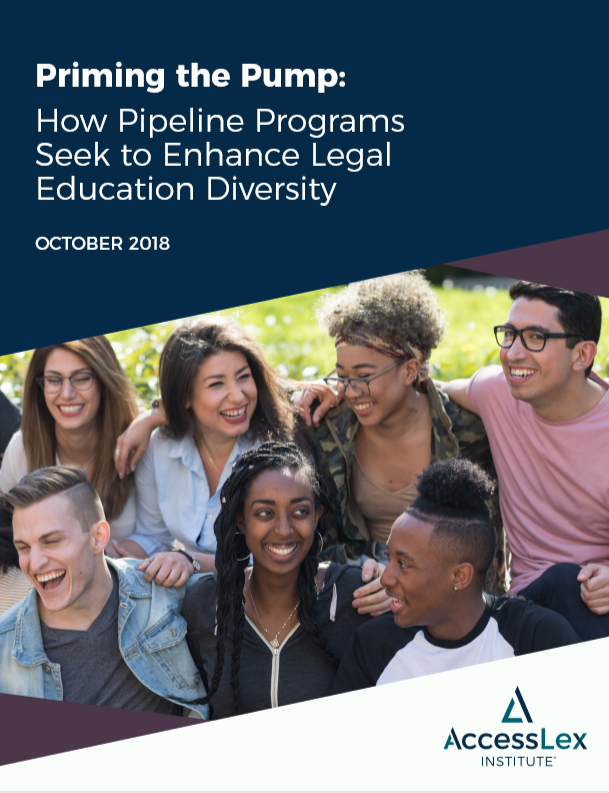Priming the Pump: How Pipeline Programs Seek to Enhance Legal Education Diversity

AccessLex Institute has developed this research brief to provide an overview of legal education pipeline programs in the U.S. – the channel by which we, as stakeholders in legal education, can improve access to law school. The prevalence of these programs and their components are discussed in detail. The brief also takes preliminary steps towards assessing their impact and effectiveness. The immediate goal is to provide useful information to aspiring students, their advisors, and others concerned about legal education diversity. The ultimate goals for future research are to identify components shared by the most effective and impactful pipeline programs, and to encourage other programs to adopt those best practices.
Introduction
From its origins, access to legal education has historically been unequal, and the trends that persist are stark. During the 2016-17 admission cycle, 75 percent of law school applicants were admitted to a law school. However, only 51 percent of black students were admitted – only two-thirds of the overall admission rate. And for Latino/a applicants, 67 percent received an offer of admission.
Admission trends manifest in the demographics of law school classes and the profession. In 2017, eight percent of first-year law students were black; 13 percent were Latino/a.1 This collective 21 percent was far below their 32 percent proportion of the nation’s population.2 And these numbers in legal education directly impact the demographics of the legal profession. Black lawyers and Latino/a lawyers each comprise only about five percent3 of the more than 1.3 million lawyers in the U.S.4
The socioeconomic backgrounds of law students and lawyers are not systematically tracked, but a recent survey estimated that 28 percent of law students were first-generation college graduates (a common proxy for socioeconomic disadvantage).5 Considering that two-thirds of adult Americans do not possess a college degree,6 these numbers strongly suggest that law students and, by extension, lawyers come from a shallow pool and that intractable barriers to entry persist.
In order to diversify legal education and the legal profession, legal education stakeholders must consider the impact of their recruitment and admission practices on enrollment trends. It is also important that we create and support effective means of aiding prospective students from underrepresented backgrounds through the legal education pipeline, from pre-application to the profession.
AccessLex Institute has developed this research brief to provide an overview of legal education pipeline programs in the U.S. – the channel by which we, as stakeholders in legal education, can improve access to law school. The prevalence of these programs and their components are discussed in detail. The brief also takes preliminary steps towards assessing their impact and effectiveness. The immediate goal is to provide useful information to aspiring students, their advisors, and others concerned about legal education diversity. The ultimate goals for future research are to identify components shared by the most effective and impactful pipeline programs, and to encourage other programs to adopt those best practices.
1 Out of 40,933 ILs, 3,535 were black, 5,434 were Latino/a. Does not include three law schools in Puerto Rico. American Bar Association (2017). 1L Enrollment by Gender & Race/Ethnicity (Aggregate). Retrieved from https://www.americanbar.org/groups/legal_education/resources/statistics/
2 United States Census Bureau, Quick Facts, Retrieved from https://www.census.gov/quickfacts/fact/table/US/PST045217
3 ABA National Lawyer Population Survey, 10-Year Trend in Lawyer Demographics, Retrieved from https://www.americanbar.org/content/dam/aba/ administrative/market_research/national-lawyer-population-10-year-demographics-revised.authcheckdam.pdf (this link no longer exists as it has been removed by the host site)
4 Id.
5 Law School Survey of Student Engagement, Law School Scholarship Policies: Engines of Inequality, Annual Report, Retrieved from https://lssse.indiana.edu/annual-results/
6 United States Census Bureau, Quick Facts, Retrieved from https://www.census.gov/quickfacts/fact/table/US/PST045217